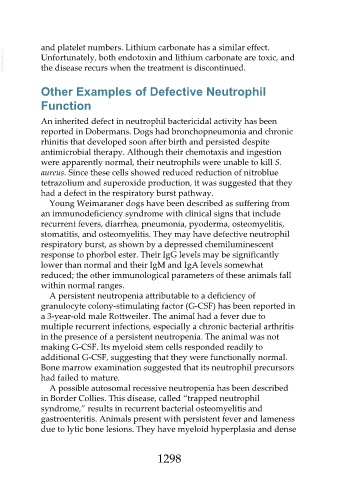Page 1298 - Veterinary Immunology, 10th Edition
P. 1298
and platelet numbers. Lithium carbonate has a similar effect.
VetBooks.ir Unfortunately, both endotoxin and lithium carbonate are toxic, and
the disease recurs when the treatment is discontinued.
Other Examples of Defective Neutrophil
Function
An inherited defect in neutrophil bactericidal activity has been
reported in Dobermans. Dogs had bronchopneumonia and chronic
rhinitis that developed soon after birth and persisted despite
antimicrobial therapy. Although their chemotaxis and ingestion
were apparently normal, their neutrophils were unable to kill S.
aureus. Since these cells showed reduced reduction of nitroblue
tetrazolium and superoxide production, it was suggested that they
had a defect in the respiratory burst pathway.
Young Weimaraner dogs have been described as suffering from
an immunodeficiency syndrome with clinical signs that include
recurrent fevers, diarrhea, pneumonia, pyoderma, osteomyelitis,
stomatitis, and osteomyelitis. They may have defective neutrophil
respiratory burst, as shown by a depressed chemiluminescent
response to phorbol ester. Their IgG levels may be significantly
lower than normal and their IgM and IgA levels somewhat
reduced; the other immunological parameters of these animals fall
within normal ranges.
A persistent neutropenia attributable to a deficiency of
granulocyte colony-stimulating factor (G-CSF) has been reported in
a 3-year-old male Rottweiler. The animal had a fever due to
multiple recurrent infections, especially a chronic bacterial arthritis
in the presence of a persistent neutropenia. The animal was not
making G-CSF. Its myeloid stem cells responded readily to
additional G-CSF, suggesting that they were functionally normal.
Bone marrow examination suggested that its neutrophil precursors
had failed to mature.
A possible autosomal recessive neutropenia has been described
in Border Collies. This disease, called “trapped neutrophil
syndrome,” results in recurrent bacterial osteomyelitis and
gastroenteritis. Animals present with persistent fever and lameness
due to lytic bone lesions. They have myeloid hyperplasia and dense
1298

